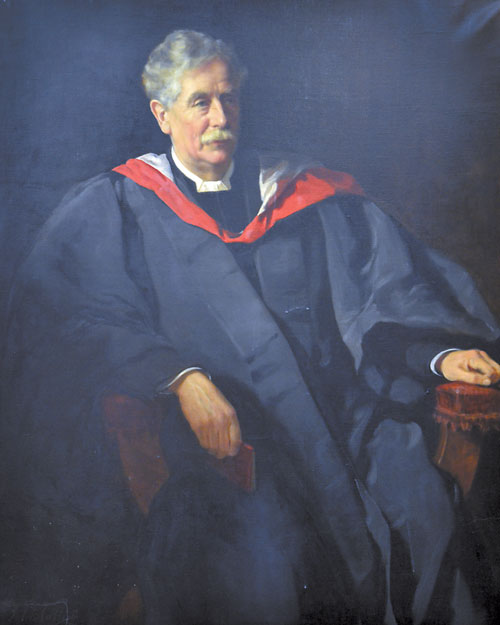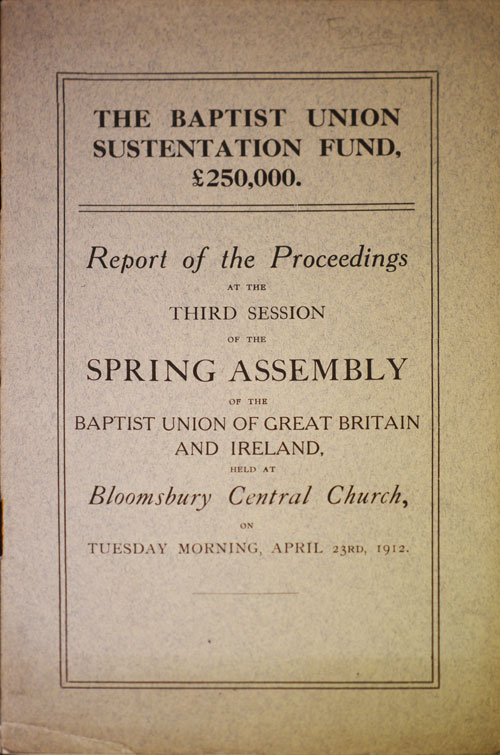
The Home Mission Story
"It is false economy to starve an Andrew Fuller!"
It’s the 1912 Baptist Assembly and General Secretary JH Shakespeare is in full flow.

Citing the early plight of the great 18th century Baptist theologian, he explained how Fuller’s salary from his church at Soham was “inadequate to provide for the expenses of a rising family…
“He was greatly depressed and nearly brought down by sorrow and sickness to the grave.”
Andrew Fuller, of course, as all those present knew, had played a key role in the founding of the Baptist Missionary Society. He was “the greatest theologian we had at the end of the 18th century.”
Shakespeare was invoking Fuller because he had moved a motion to adopt a new scheme: the Ministerial Settlement and Sustentation Scheme, and the accompanying Sustentation Fund which would pay for it. The fund would enable central financial support for mission, particularly to support the ministries of small churches which could not pay a stipend.

It proved a masterstroke: Shakespeare’s Assembly address was ‘rapturously received’ according to Ian Randall in The
English Baptists of the 20th Century and the resolution passed unanimously. Not everyone was in agreement with this new direction for the denomination, but effective mission was the goal and Baptists responded with their pockets too. Just two years on, Shakespeare was able to announce ‘with enormous satisfaction’ that the initial funding target of £250,000 (around £29m today) for the
Sustentation Fund had been reached. The Fund would produce an annual income of £15,000 to help cash strapped churches pay their minister a stipend, as well as fund other denominational initiatives. This initial capital would be supported with annual offerings of £5,000. In 1917, more than 460 grants to ministers were made. Sustaining and supporting ministry from shared funds had become an integral part of Union life.
Churches needed to act together
This was a key marker in the story of Baptists Together Home Mission, but in many ways the story can be traced back much further. Baptists have always been a missionary people. Believers’ baptism and Christian discipleship are personal responses to hearing and believing the Gospel of Jesus Christ. It is the duty and privilege of every Baptist church to bear witness to this Gospel in deed and word. But from the start it was clear that individual churches could not adequately fulfil this call from God on their own, and therefore they needed to act together.
Historically, one of the principle ways they did this was through their associating together with other Baptist churches, which enabled them to support each other and to co-operate in this missionary enterprise.
Another way of working together in mission and evangelism was through societies established specifically for that purpose. The Baptist Missionary Society, formed in 1792, was the most famous of these, but there were others devoted to mission at home.
A Baptist Home Missionary Society began its life in London in 1797, and over the years supported many itinerant evangelists. The Baptist colleges, which were themselves expressions of co-operation between the churches, also sent their students out to preach as part of their training.
There was a biblical imperative behind this co-operation: on the one hand, the strong helping the weak, and also local churches reaching out to support one another. These are principles laid down in the New Testament.
A national strategy for the dawning of a new century
As the 19th century drew to a close, many began to feel that the different ways in which churches co-operated in mission at home, through associations, societies and colleges, should be better organised. There needed to be a national strategy to cope with the demands of the modern world. The obvious way of doing this was through the Baptist Union.
Under the dynamic leadership of Shakespeare, General Secretary of the Union between 1898 and 1924, a series of reforms were undertaken with the aim of enabling churches to work together nationally, rather than in the somewhat piecemeal way of the past. Money was raised for the Union to support church planting and other missionary initiatives: the first major project he undertook was the promotion of what was called a
Twentieth Century Fund for the denomination. The goal was to raise £250,000 for evangelising and church extension, student scholarships, a new Baptist church house in London, and educational and other projects.

Despite this being a massive target, the churches responded to the fresh challenge put before them. In 1902 the fundraising campaign was successful, not so much ‘due to old loyalties as to new enthusiasm’, noted Ian Randall in
The English Baptists of the 20th Century. ‘This Fund was an astonishing achievement and signalled Baptist denomination renewal.’
Over the next few years, processes for ensuring that ministers were properly trained and paid were put in place; various different funds were amalgamated and put under the stewardship of the Union; a new order of deaconesses to engage in urban mission was established; a scheme to facilitate the movement of ministers between churches was set up. (‘The number of new initiatives at the beginning of this century makes breathtaking reading’, wrote David Coffey in
The Home Mission Story). So that these initiatives could be sustained, an annual financial appeal to the churches was made (the Sustentation Fund) – and here we have the official beginnings of Baptists Together Home Mission.
Developments across the years
The annual appeal has continued ever since, consistently adapted to meet the challenges of the day. In the 1940s it became the new
Home Work Fund, which aimed to secure uniformity of treatment for all Associations and an agreed ministerial stipend for those in receipt of grants. In 1970 it became the
Home Mission Fund. Its scope has broadened into the 21st century: Home Mission grants are now made by Associations – a change which arose from the 2012 Futures Process – with a renewed focus on mission.

Douglas Sparkes, author of 1995’s
The Home Mission Story, stated that throughout the history of Home Mission ‘it has not been possible consistently to sustain the level of income to meet demand.’ Factors have been the general economic climate impacting on church finances, alongside an emphasis on the local church overriding concepts of responsibility for other churches.
‘Over the years Home Mission in its various forms has achieved so much’, he concluded. ‘So much more could be accomplished if it was given in all places the priorities that Baptists ought to accord it.’
Peter Shepherd is a Baptist minister and the author of several articles and two books on Baptist history: The Making of a Modern Denomination and The Making of Northern Baptist College.

This article first appeared in the
Autumn 2019 edition of Baptists Together magazine